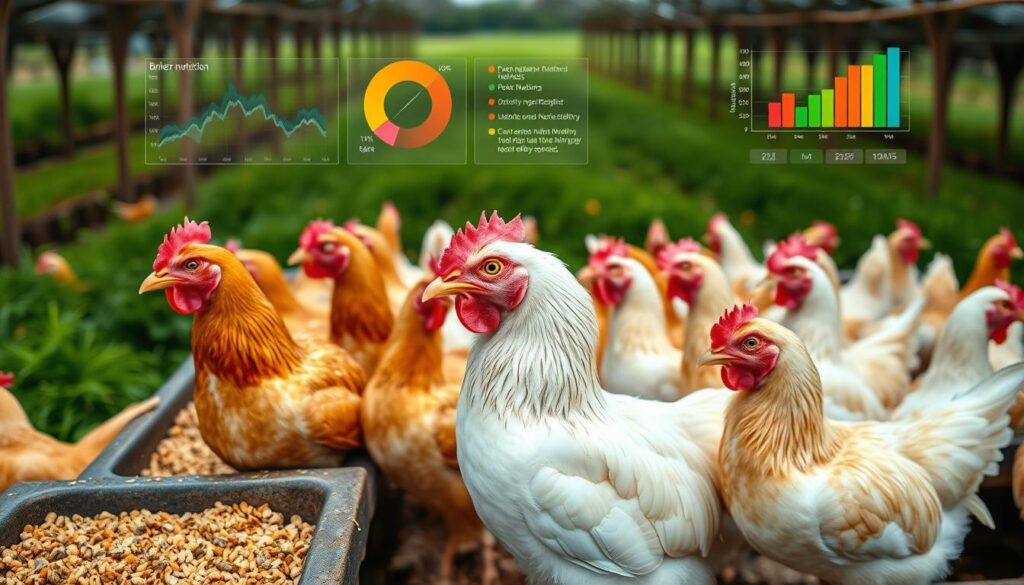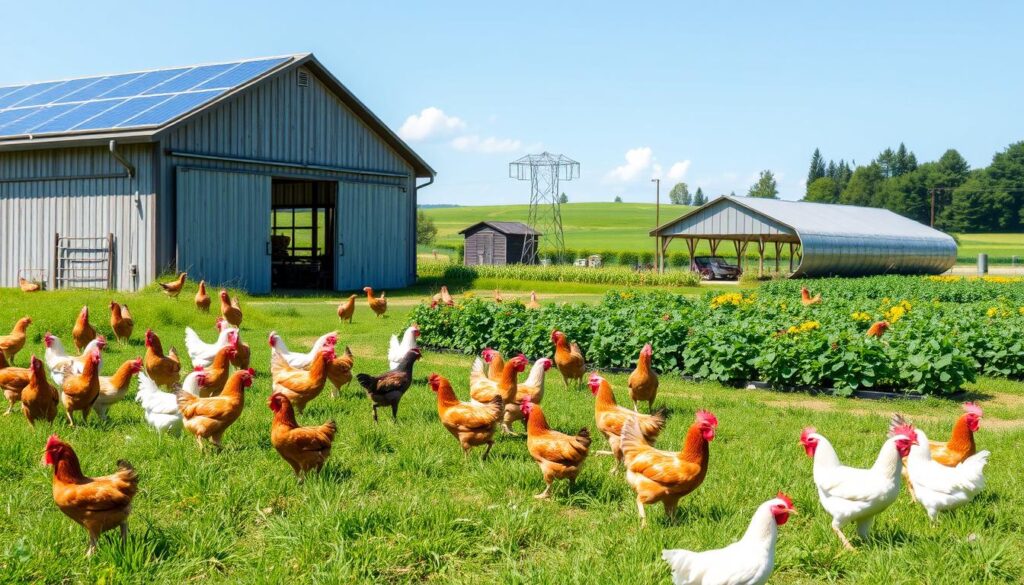
In the world of poultry, making sure broiler chicken diets are balanced is key. This ensures fast growth, good feed use, and health. We’ll look at how to mix nutrients for the best results. This includes knowing about nutrient density and amino acid balance, and using the Balanced Nutrient Density (BND) method.
Key Takeaways
- The importance of balancing broiler diets for optimal performance in terms of growth, feed efficiency, and sustainable production.
- Understanding the concepts of nutrient density and amino acid balance, and how they impact broiler performance.
- Exploring the Balanced Nutrient Density (BND) approach and its criteria for formulating broiler diets.
- Insights into experimental designs and diet formulation techniques for broiler chickens.
- The role of age-related nutrient digestibility in broiler performance.
Understanding Nutrient Density and Amino Acid Balance
In broiler chicken nutrition, two key factors are important: nutrient density and amino acid balance. Nutrient density means having the right amount of energy, vitamins, and minerals. It’s about how much of these nutrients are in the feed compared to metabolizable energy (ME).
Amino acid balance is about the right mix of digestible lysine to ME. It makes sure all amino acids are balanced with lysine.
Nutrient Density: The Optimal Supply of Non-Nitrogenated Nutrients
Keeping the right nutrient density is key for broiler chickens. It ensures they get the nutrients they need, like energy, vitamins, and minerals. This helps them stay healthy, grow well, and perform better.
Amino Acid Balance: Digestible Lysine-to-Metabolizable Energy Ratio
Amino acids, like lysine, are crucial for poultry. The digestible lysine-to-metabolizable energy (DLYS:ME) ratio is important in making broiler diets. It affects growth, how well they use feed, and nutrient absorption.
Research shows balancing amino acids in the diet helps. It can lower the need for crude protein, leading to better growth. It also supports digestion, metabolism, and immunity. This helps prevent diseases like necrotic enteritis.
“Amino acid chelated trace minerals, when included in the diet, can enhance gut health and reduce the impact of heat stress on broiler chickens.”
Understanding nutrient density and amino acid balance helps broiler producers. They can improve feeding strategies for better performance, feed efficiency, and sustainable production.
The Balanced Nutrient Density (BND) Concept
The Balanced Nutrient Density (BND) concept is a new way to make broiler diets. It aims to increase profits, unlike old methods that focus on fixed nutrient levels. It uses two main criteria: Nutrient Density and Balanced Amino Acids-to-Energy Ratio.
Criteria 1: Nutrient Density
Nutrient density means giving the right amount of vitamins, minerals, and other important compounds. This is compared to the diet’s energy content. It helps broilers get the nutrients they need without too much energy, which can waste money and resources.
Criteria 2: Balanced Amino Acids-to-Energy Ratio
The second part of BND is the digestible lysine-to-metabolizable energy ratio (DLYS:ME). This ratio makes sure amino acids match the diet’s energy. This balance helps broilers grow well and use feed efficiently, improving their performance and how well they eat.
The BND concept is a flexible way to make broiler diets. It lets farmers adjust nutrient levels and amino acid balance for their specific needs and budget. This method aims to make broiler farming more profitable by balancing nutrient supply and energy intake.
“The Balanced Nutrient Density (BND) concept offers a comprehensive approach to broiler diet formulation, focusing on the optimal supply of essential nutrients and the balanced ratio of amino acids to energy. This flexible system can help maximize the profitability of broiler production by optimizing nutrient utilization and feed efficiency.”
Experimental Design: Exploring BND and DLYS:ME Ratios
To study the effects of Balanced Nutrient Density (BND) and the DLYS:ME ratio on broiler chickens, researchers did a big Broiler Chicken Experiments study. They used a 3 × 2 Factorial Arrangement to look at two nutrient levels and three DLYS:ME ratios.
672 one-day-old male Ross 308 broiler chickens were used in two 42-day trials. Each diet was tested eight times. This setup let the researchers deeply explore the BND Concept and DLYS:ME Ratios. They found out how these affect broiler growth, feed use, and nutrient use.
- The study used a 3 × 2 Factorial Arrangement of treatments. They looked at two nutrient levels and three DLYS:ME ratios.
- 672 one-day-old male Ross 308 broiler chickens were used in two 42-day trials. Each diet was tested eight times.
- This design helped researchers fully study the effects of the BND Concept and DLYS:ME Ratios on broiler performance.
This strong experimental method helped researchers collect a lot of data. They found out the best Broiler Chicken Experiments, BND Concept, and DLYS:ME Ratios for better broiler performance and efficiency.
Diet Formulation: Starter and Finisher Diets
The researchers used a two-phase feeding program for broiler chickens. They gave them a starter diet from hatch to day 21. Then, a finisher diet from day 21 to 42. They carefully planned the nutrient density and digestible lysine-to-metabolizable energy (DLYS:ME) for both diets.
Nutrient Composition of Starter Diets
The starter diets had different levels of metabolizable energy (ME). The low-density diets had 2,876 kcal/kg, while the high-density diets had 3,169 kcal/kg. The high-density diets had more non-nitrogenated nutrients to increase energy.
The study looked at how these differences in starter diets affected growth, feed efficiency, and nutrient use. They aimed to find the best feeding strategies for broiler chickens in the starter phase.
“Balancing the nutrient composition of broiler starter diets is crucial for optimizing growth and feed efficiency during the critical early stages of development.”
This research on starter diets gives important insights to poultry producers. It helps them improve their broiler operations’ performance and sustainability.
How to Balance Broiler Chicken Diets for Optimal Performance
Balancing broiler chicken diets is key to their top performance. It ensures they eat well, grow fast, and use feed efficiently. This leads to better profits and a more sustainable operation.
The digestible lysine-to-metabolizable energy (DLYS:ME) ratio is crucial. Studies show that broilers on low DLYS:ME diets eat less than those on medium or high diets. Birds on low DLYS:ME diets were the lightest, while those on medium were the heaviest.
The interaction between nutrient density and DLYS:ME affects feed conversion ratio (FCR). Birds on low density x low DLYS:ME diets had the worst FCR. But, as DLYS:ME increased, FCR improved, reaching its best at high density x medium DLYS:ME.
| Nutrient Density | DLYS:ME Ratio | Feed Intake | Body Weight Gain | Feed Conversion Ratio |
|---|---|---|---|---|
| Low | Low | Lowest | Lightest | Highest |
| Medium | Medium | Higher | Heaviest | Improved |
| High | Medium | Highest | Heaviest | Optimal |
To achieve optimal Broiler Diet Balancing and Performance Optimization, producers should focus on:
- Maintaining a balanced Feed Intake and Weight Gain through appropriate DLYS:ME ratios
- Optimizing Feed Efficiency by striking the right balance between nutrient density and amino acid-to-energy ratio
- Leveraging high-quality, nutrient-dense feed formulations to support rapid growth and development
“Proper diet formulation is the foundation of efficient broiler production. By balancing key nutritional factors, producers can unlock the full potential of their flocks and deliver exceptional performance.”
Age-Related Nutrient Digestibility in Broilers
As broiler chickens grow, their ability to digest nutrients changes a lot. Studies show that jejunal and ileal starch and protein digestibility change on days 21 and 42, but not on day 7. This means that how well broilers digest nutrients changes as they get older. This affects their performance and how they react to different diets.
The way broilers digest starch and protein changes a lot as they age. This change in how they use nutrients is very important. It shows why we need to adjust their diets as they grow.
| Nutrient Digestibility | Day 7 | Day 21 | Day 42 |
|---|---|---|---|
| Starch | Unaffected | Impacted | Impacted |
| Protein | Unaffected | Impacted | Impacted |
These findings highlight the need for a detailed approach to broiler nutrition. Diets should be carefully planned to match the changing nutrient digestibility of the birds. By understanding and adjusting to these changes, producers can improve broiler performance and make sure nutrients are used efficiently.

“Understanding the age-related shifts in nutrient digestibility is crucial for formulating diets that cater to the evolving needs of broiler chickens throughout their growth cycle.”
Performance Outcomes: Growth, Feed Efficiency, and Nutrient Utilization
The balanced nutrient density (BND) approach in broiler diet formulations shows great promise. It can improve growth and how well broilers use their food. As the digestible lysine-to-metabolizable energy (DLYS:ME) ratio goes up, broilers use less energy to grow.
Studies suggest that using the BND system can lead to better Broiler Growth, Feed Efficiency, and Nutrient Utilization. It helps balance nutrients and amino acids for each bird’s needs. This results in better Calorie Conversion and overall performance.
| Performance Metric | Findings |
|---|---|
| Broiler Growth | Studies have shown that higher DLYS:ME ratios can improve broiler growth and development, leading to increased body weight gain. |
| Feed Efficiency | The BND approach has demonstrated the potential to enhance feed conversion ratio (FCR) in broiler chickens, indicating improved utilization of dietary nutrients. |
| Nutrient Utilization | Calorie conversion, a measure of the broilers’ ability to utilize dietary energy for growth, linearly decreased with increments in DLYS:ME ratios. |
Using the BND system in broiler diets can be a game-changer. It helps ensure efficient Broiler Growth, Feed Efficiency, and Nutrient Utilization. This is key for sustainable poultry farming.
Implications for Sustainable Broiler Production
Research on broiler chicken diets has big implications for sustainable production. The Balanced Nutrient Density (BND) concept is key. It focuses on nutrient density and balanced amino acids-to-energy ratio. This can improve nutrient use and make broiler operations more sustainable.
Using the BND approach can make broiler production more profitable and environmentally friendly. This is crucial because the broiler industry is huge. In 2018, the U.S. alone slaughtered over 9 billion chickens. This produced about 20 million metric tons of chicken meat, worth over $31.7 billion.
The study looked at using alternative protein sources like corn gluten meal and sunflower meal. These can reduce the need for soybean meal. This could make broiler production more sustainable and profitable.
| Key Sustainability Metrics | Conventional Broilers | Slower-Growing Breeds |
|---|---|---|
| Land Use | Baseline | 19.9% – 60.1% increase |
| Annual Slaughter Rate | 9.25 billion | 44.6% – 86.8% increase |
| Chicken Population | Baseline | 44.6% – 86.8% increase |
Slower-growing breeds might have better welfare and less environmental impact. But, they also use more land and have higher slaughter rates. The Balanced Nutrient Density approach is a good solution. It optimizes broiler performance and sustainability without big changes to the industry.

“By optimizing the use of feed resources through the BND approach, farmers can improve the profitability and environmental impact of their broiler production.”
This research shows the importance of balanced broiler chicken diets for sustainable production. As the industry grows, using innovative feeding strategies like BND is key. It helps improve nutrient use, reduce environmental impact, and keep production profitable.
This article has looked into Balanced Nutrient Density (BND) for broiler chicken diets. It shows how BND helps in achieving optimal performance. It uses a mix of nutrient density and a balanced amino acid-to-energy ratio.
The study highlights the need to balance energy, amino acids, and other nutrients. This balance is key for broiler growth, feed efficiency, and sustainable production. By using BND, producers can improve performance and use resources better. This helps make the poultry industry more sustainable.
As the poultry industry grows, this article’s insights are crucial. They help producers make better broiler diets. This ensures high-quality, affordable, and eco-friendly broiler meat for everyone.